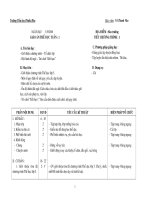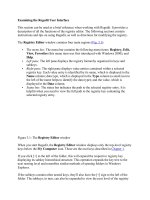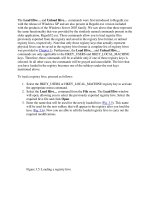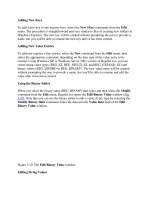Tài liệu Examining the Army’s Future Warrior - Force-on-Force Simulation of Candidate Technologies pdf
Bạn đang xem bản rút gọn của tài liệu. Xem và tải ngay bản đầy đủ của tài liệu tại đây (1.68 MB, 82 trang )
This PDF document was made available
from www.rand.org as a public service of
the RAND Corporation.
6
Jump down to document
Purchase this document
Browse Books & Publications
Make a charitable contribution
Visit RAND at www.rand.org
Explore the RAND Arroyo Center
View document details
This document and trademark(s) contained herein are protected by law
as indicated in a notice appearing later in this work. This electronic
representation of RAND intellectual property is provided for non-
commercial use only. Permission is required from RAND to reproduce, or
reuse in another form, any of our research documents.
Limited Electronic Distribution Rights
For More Information
Support RAND
CHILDREN AND ADOLESCENTS
CIVIL JUSTICE
EDUCATION
ENERGY AND ENVIRONMENT
HEALTH AND HEALTH CARE
INTERNATIONAL AFFAIRS
POPULATION AND AGING
PUBLIC SAFETY
SCIENCE AND TECHNOLOGY
SUBSTANCE ABUSE
TERRORISM AND
HOMELAND SECURITY
TRANSPORTATION AND
INFRASTRUCTURE
U.S. NATIONAL SECURITY
The RAND Corporation is a nonprot
research organization providing
objective analysis and effective
solutions that address the challenges
facing the public and private sectors
around the world.
This product is part of the RAND Corporation monograph series.
RAND monographs present major research ndings that address the
challenges facing the public and private sectors. All RAND mono-
graphs undergo rigorous peer review to ensure high standards for
research quality and objectivity.
RANDALL STEEB
JOHN MATSUMURA
PAUL STEINBERG
TOM HERBERT
PHYLLIS KANTAR
PATRICK BOGUE
Prepared for the United States Army
Approved for public release, distribution unlimited
Examining the
Army’s Future
Warrior
Force-on-Force Simulation of
Candidate Technologies
The RAND Corporation is a nonprofit research organization providing
objective analysis and effective solutions that address the challenges
facing the public and private sectors around the world. RAND’s
publications do not necessarily reflect the opinions of its research clients
and sponsors.
R
®
is a registered trademark.
© Copyright 2004 RAND Corporation
All rights reserved. No part of this book may be reproduced in any form
by any electronic or mechanical means (including photocopying,
recording, or information storage and retrieval) without permission in
writing from RAND.
Published 2004 by the RAND Corporation
1700 Main Street, P.O. Box 2138, Santa Monica, CA 90407-2138
1200 South Hayes Street, Arlington, VA 22202-5050
201 North Craig Street, Suite 202, Pittsburgh, PA 15213-1516
RAND URL: />To order RAND documents or to obtain additional information, contact
Distribution Services: Telephone: (310) 451-7002;
Fax: (310) 451-6915; Email:
Library of Congress Cataloging-in-Publication Data
Examining the Army’s future warrior : force-on-force simulation of candidate
technologies / Randall Steeb [et al.].
p. cm.
Includes bibliographical references.
“MG-140.”
ISBN 0-8330-3518-5 (Paperback)
1. Military research—United States. 2. Combat—Simulation methods. 3.
Military doctrine—United States. 4. United States. Army—Reorganization. I.
Steeb, Randall, 1946– II. Rand Corporation.
U393.E95 2004
355.5—dc22
2003023340
The research described in this report was sponsored by the United States
Army under Contract No. DASW01-01-C-0003.
iii
Preface
This report summarizes work performed during a quick-response
analytic effort in support of the 2001 Army Science Board (ASB)
Summer Study on Objective Force Soldier, along with subsequent ef-
forts in related areas. The work used high-resolution constructive
simulation to examine key aspects of “objective soldier,” with the
modeling taking place in the 2015–2020 time frame. In conducting
the study, the research team interacted with various members of the
ASB and, in particular, with key members of the Analysis, Fightabil-
ity, and Concepts panels, drawing extensively on their forward-
looking ideas and ultimately integrating many of these ideas into the
research. The primary scenario employed was a highly stressing mis-
sion involving a dismounted attack on an enemy position in complex
terrain.
This work should be of interest to those involved in technology
assessment, force structure, and examination of new tactical concepts.
This research was sponsored by the Assistant Secretary of the
Army (Analysis, Logistics and Technology) and was conducted in the
Force Development and Technology Program of RAND Arroyo
Center. The Arroyo Center is a federally funded research and devel-
opment center sponsored by the United States Army.
iv Examining the Army’s Future Warrior
For more information on RAND Arroyo Center, contact the Direc-
tor of Operations (telephone 310-393-0411, extension 6419; FAX
310-451-6952; e-mail ), or visit the Arroyo
Center’s web site at />v
The RAND Corporation Quality Assurance Process
Peer review is an integral part of all RAND research projects. Prior to
publication, this document, as with all documents in the RAND
monograph series, was subject to a quality assurance process to ensure
that the research meets several standards, including the following:
The problem is well formulated; the research approach is well de-
signed and well executed; the data and assumptions are sound; the
findings are useful and advance knowledge; the implications and rec-
ommendations follow logically from the findings and are explained
thoroughly; the documentation is accurate, understandable, cogent,
and temperate in tone; the research demonstrates understanding of
related previous studies; and the research is relevant, objective, inde-
pendent, and balanced. Peer review is conducted by research profes-
sionals who were not members of the project team.
RAND routinely reviews and refines its quality assurance pro-
cess and also conducts periodic external and internal reviews of the
quality of its body of work. For additional details regarding the
RAND quality assurance process, visit />standards/.
vii
Contents
Preface iii
Figures and Table
ix
Summary
xi
Acknowledgments
xvii
List of Acronyms
xix
CHAPTER ONE
Introduction 1
Background
1
Objective
2
Methodology
3
Scenarios Chosen
4
Simulation Tools Used for the Analysis
7
Organization of This Document
9
CHAPTER TWO
How Might a Current-Generation Soldier Unit Perform in a
Challenging Combat Operation?
11
How Does the Current-Generation Soldier Unit Fare?
11
Why Do We See the Results We Do?
12
CHAPTER THREE
What Are Some Key, High-Leverage Technologies for the Objective
Soldier?
17
What Technologies Are Examined?
17
viii Examining the Army’s Future Warrior
What Are Some Other Potential Excursions? 19
CHAPTER FOUR
What Is the Impact of Such Technologies in Combat, Using High-
Resolution Simulation?
21
What Effect Do Future Technologies Have on the Performance of
Future Objective Soldier?
21
Excursions on Individual Technology Options
22
Excursions on Synergistic Effect of Multiple Options
29
What Effect Do “Far Future” Technologies Have on the Performance
of the Future Objective Soldier?
31
CHAPTER FIVE
What Are Some of the Alternatives (Non-Soldier-Based) for
Accomplishing the Same Mission?
39
What Can We Learn from Other Relevant Studies About Fighting in
Complex Terrain as in Scenario 1?
39
What Can We Learn from Other Relevant Studies About Fighting in
MOUT Situations as in Scenario 2?
45
What Improvements in Modeling and Simulation Are Needed for
Representing Dismounted Infantry Operations and Complex
Terrain?
49
CHAPTER SIX
Observations and Conclusions 55
Bibliography
58
ix
Figures and Table
Figures
S.1. LER Improvements as Individual Changes and Then
Combinations of Changes Are Made to the Blue Force
xiii
1.1. Modification of High-Resolution Fort Hunter Liggett Terrain
to Represent Kosovo Engagement
5
1.2. Details of Scenario 1
6
1.3. Details of Scenario 2
7
1.4. Simulation Environment Used for This Analysis
8
2.1. Results of Baseline Case for Current-Generation Soldier Unit
12
2.2. Janus Screen Showing Good Lines of Sight for the Red Force
13
2.3. JCATS Screen Showing Composite Lines of Sight for the Red
Force
13
2.4. Detections, Shots, and Kills for the Blue and Red Forces
14
2.5. The Effects of Poor Weather on Detections of Blue Forces
15
3.1. Various Technologies to Improve Soldier Operations
18
4.1. Different Conditions Examined in the Analyses
22
4.2. Effect of Reducing Signature
23
4.3. Performance of XM-29 by Target Characteristics
24
4.4. Effects of Smoke
25
4.5. Effect of Cannon Fire Without Good Knowledge of Enemy
Positions
27
4.6. Effect of MLRS with DPICM Without Good Knowledge of
Enemy Positions
28
4.7. Effect of Fires with Good Knowledge of Enemy Positions
29
x Examining the Army’s Future Warrior
4.8. Effect of Synergies of Indirect Fire, XM-29, and Body Armor 30
4.9. Effect of Synergies of Indirect Fire, XM-29, and Body Armor
on LERs
31
4.10. Effects of Faster and Slower Sprint Speed Under Heavier Load
32
4.11. Effects of Adding Very-High-Quality Body Armor
33
4.12. Effects of Further Reducing Signature
34
4.13. Effects of Outfitting Only a Portion of Force with XM-29
34
4.14. Effects of XM-29 and M-16 on LER
35
5.1. Effects of C2 Delay on Indirect Fire Munitions
41
5.2. Effects of Different Types of Intelligence Gathering by the
Light Force
42
5.3. Importance of Sensor Height on UGVs
43
5.4. Effect of Reducing UGV Size on Detections
44
5.5. Effect of Using Armed UGVs for Recon
45
5.6. Difficulty of Attacking an Urban Area
46
5.7. Modeling MOUT “Pointman” Function Using Janus
46
5.8. Effects of Using UGVs in Convoys in MOUT Scenario
48
5.9. Effect of Smoke on Convoy Survivability in MOUT Scenario
48
5.10. An Illustration of the Problem of Noncombatants (White)
Using JCATS
50
5.11. Usefulness of Visualization Programs in MOUT Modeling
Using OneSAF Testbed
50
5.12. Usefulness of OTB Maps in Showing Terrain
51
5.13. Movement in Three-Dimensional Terrain Represented by
OTB
52
5.14. A MOUT Scenario Represented Using OTB
52
5.15. An Alternative MOUT Scenario Represented in JCATS
53
Table
4.1. Effects of Adding “Junkyard Dogs” to the Force 37
xi
Summary
Introduction
The U.S. Army is in the process of adapting to meet the needs of the
new millennium. The vision for accomplishing this, as defined by the
senior Army leadership, will ultimately lead to an increase in the
Army’s ability to quickly and effectively respond to situations across a
full spectrum of contingencies. Much of this work has focused on ex-
amining alternative vehicle platforms and technologies for the Future
Combat Systems (FCS) concept.
1
As a result, integrating the FCS
concepts with future dismounted operations has not been given com-
parable levels of attention, although soldier systems occupy a promi-
nent position in Army and Lead System Integrator (LSI) documents.
2
The Army Science Board (ASB) Summer Study attempted to balance
the picture by focusing on the future soldier.
3
The purpose of the
work reported here is to provide an initial quantitative exploratory
analysis of objective soldier options, within the context of several
_____________
1
Matsumura et al., Exploring Advanced Technologies for the Future Combat Systems Program,
Santa Monica, CA: RAND Corporation, MR-1332-A, 2002.
2
Department of the Army, Army Materiel Systems Analysis Activity, Army Future Combat
Systems Unit of Action Systems Book, Version 3.0, May 13, 2003.
3
This study and many other examinations of future soldier systems are reported in the ASB
2001 Summer Study on the Objective Force Soldier/Soldier Team. An electronic copy can
be found at />xii Examining the Army’s Future Warrior
stressing scenarios. The effort focuses on a series of research ques-
tions, starting with How might a current-generation dismounted
force perform in a challenging combat situation? and ending with
What are the impacts of key, high-leverage technologies in combat?
The report also references relevant research prior and subsequent to
the ASB summer study.
Approach
Our approach entails a constructive simulation effort that centers on
using Janus
4
and a set of locally connected models to represent dis-
mounted operations. Two scenarios were examined, the first a dis-
mounted Blue force attack on a Red force defending inside a treeline,
and the second a convoy operation through an urban area. A high-
resolution terrain database describing Fort Hunter Liggett was modi-
fied with additional foliage to represent the treeline scenario, while
data from Sarajevo were used to represent the urban convoy opera-
tion. The primary focus of this work was on the treeline scenario.
Before using Janus and associated models, we examined the
benefits possible by changing to more sophisticated models: JCATS
(Joint Conflict and Tactical Simulation) and OTB (OneSAF Test-
bed). Each of these models offers advantages when representing urban
terrain, including the modeling of noncombatants and presenting the
results in the form of 3-D visualization.
Findings
The bulk of our work focused on use of the treeline scenario. Here, a
40-soldier platoon of Blue dismounted soldiers attacked a 13-soldier
squad of Red infantry dug into a treeline. The attack was made under
covering fire by machine guns, with the force advancing in alternat-
_____________
4
Janus is a system-level force-on-force simulation originally developed by Lawrence
Livermore National Laboratory.
Summary xiii
ing sprints. We started with a current-generation force, with riflemen
with M-16s, M-240 machine gunners, and grenadiers, facing an en-
emy squad with AK-74s and machine guns. The current Blue force
was basically unsuccessful, losing half of its number while the enemy
also lost half of its force.
Improvements to the force were tested one at a time and then in
combination, and the results (stated as a ratio of improvement to the
baseline) are shown in Figure S.1. Adding stealth and smoke to Blue
did not improve the outcome, instead simply reducing the typical
range of detections, shots, and kills. Adding body armor, the OICW
Figure S.1
LER Improvements as Individual Changes and Then
Combinations of Changes Are Made to the Blue
Force
(Base given value of 1 in chart, actual base case LER = 0.38)
LER improvement over baseline
6
4
2
18
0
+ Signature reduction
+ BA
+ XM-29
+ Smoke
Base
RANDMG140-S.1
NOTE: BA = Body Armor
IDF = Indirect fires.
+ IDF
+ IDF + XM-29
+ IDF + XM-29 + BA
16
14
12
10
8
xiv Examining the Army’s Future Warrior
weapon (Objective Individual Combat Weapon—a rifle and preci-
sion explosive round combination—now designated the XM-29), and
its forward-looking infrared (FLIR) sensor
5
each helped, but none
achieved more than a moderate improvement to the outcome. Link-
ing the force to indirect fires (we used precision cannon fire and mis-
sile-based area fires with dual-purpose improved conventional muni-
tion—DPICM) attrited some 25 percent of the enemy force and
suppressed another portion of it for a short period.
The real differences in outcome came when combinations of
improvements were made. When indirect fire and the OICW weapon
and FLIR were used, the loss-exchange ratio (LER, here the number
of enemy dismounts killed divided by the number of Blue dismounts
killed) improved fivefold. When body armor was then added to this
mix (able to stop most small arms fire), the LER improvement
reached seventeen times the original level. This synergy appeared to
result from the indirect fire attriting the part of the enemy force (ma-
chine gun teams) that was the main threat to body armor, thus ena-
bling massed Blue fires to be more effective.
Some additional excursions were also revealing. Additional speed
of movement by Blue did not help, again just reducing the range of
engagement, but slower movement actually hurt. A high level of body
armor protection (90 percent against the 7.62 machine gun) made a
substantial difference, but there is some question whether this level of
body armor protection may be achievable. Surprisingly, equipping
only one-sixth of the force with OICW resulted in roughly half the
benefits of equipping the entire force. Alternatively, adding six armed
unmanned ground vehicles (small UGVs about 1 meter tall) to the
Blue force increased survivability of manned systems and improved
lethality against the enemy. In fact, the combination of adding six
armed UGVs and equipping six soldiers with OICW resulted in per-
formance equivalent to equipping all the Blue force with OICW.
_____________
5
In the study we assumed the basic room-temperature FLIR planned for the OICW (similar
to Javelin FLIR performance), but we also examined the use of a cooled second-generation
FLIR.
Summary xv
The second, convoy scenario showed that smoke and UGVs can
make a difference, if Blue is not attacking a fixed position. Use of
smoke and addition of unmanned vehicles gave much greater surviv-
ability in the urban passage, especially when the UGVs were armed.
Conclusions
We found that even in a very stressing attack scenario, a Blue dis-
mounted force with a combination of technologies could defeat an
entrenched Red force. The key improvements in this scenario were
the OICW weapon and FLIR, links to indirect fires, and capable
body armor. In other scenarios, use of obscurants and UGVs may
also make significant contributions to survivability. The importance
of synergies between systems was especially evident in the studies we
made.
Tradeoffs were evident in many runs. Equipping only a portion
of the force resulted in a more than proportional improvement in
outcome, indicating decreasing marginal returns. Reachback fires
were useful, but they required substantial firepower to achieve a lim-
ited number of kills of dug-in forces.
This quick-reaction study relied on Janus for most of the ana-
lytic findings. Our parallel examinations of JCATS and OTB showed
that these simulation tools had great potential for modeling interior
fighting, representing noncombatant interactions and collateral dam-
age, and visualizing event chains.
6
At the same time, more needs to be
done using man-in-the-loop simulation (especially for command and
control issues) and field experiments. The scale of the analysis also
needs to increase, with studies devoted to such questions as how
closely linked the dismounts should be to the FCS vehicles, the link-
ages needed for controlling air and ground robotics, and development
of new MOEs and MOPs (measures of effectiveness and perform-
_____________
6
While we did not directly compare Janus, JCATS, and OTB across the same scenarios, we
found that Janus and JCATS had roughly similar outcomes in similar situations. A full de-
termination of consistency between these models needs to be made.
xvi Examining the Army’s Future Warrior
ance) for operations in complex terrain. All these aspects should be
explored in upcoming analytic efforts.
xvii
Acknowledgments
The authors would like to thank the numerous individuals who gen-
erously contributed their time to this research effort. The authors
must first acknowledge the key contributions provided by the various
members and affiliates of the ASB. Outstanding guidance and, in
some cases, support were provided by Dr. Robert Douglas, GEN(R)
David Maddox, LTG(R) Charles Otstott, GEN(R) Wayne Downing,
Dr. Anthony Tether, Dr. Stuart Starr, Dr. Michael Macedonia, Mr.
Dan Rondeau, and Mr. Ed Brady. Additionally, we thank the fol-
lowing individuals for their insights and comments during the spring
and summer period of the study: Dr. Joseph Braddock, Ms. Karen
Williams, and Dr. Warren Morrison.
Second, the authors wish to thank our sponsors from the Office
of the Assistant Secretary of the Army for Acquisition, Logistics, and
Technology: Dr. Michael Andrews, Dr. Lawrence Stotts, and Dr.
Pam Beatrice. They gave valuable direction to the work.
Others who helped with this work include Doug Parsons from
STRICOM, who provided useful insights on OneSAF capabilities,
architecture, and installation, Mike Uselak from LLNL, who helped
us in exploring JCATS, and COL Bruce Jette from Natick, who pro-
vided enlightening information on objective force soldier.
Finally, the authors thank their RAND Corporation colleagues
who shared their ideas and gave generously of their time: LTC Mi-
chael Barbero, LTC Fred Gellert, Rob Cochran, Gail Halverson, Dr.
Ken Horn, John Gordon, Dr. Walt Perry, Dr. Jon Grossman, LTC
David Nadeau, and LTC Kent Fasana.
xix
List of Acronyms
AK-74 5.45mm Russian automatic rifle
APS Active Protection System
ASB Army Science Board
ATR Automatic Target Recognition
BA Body Armor
BCT Brigade Combat Team
C2 Command and Control
CAGIS Cartographic Analysis and Geographic In-
formation System
DARPA Defense Advanced Research Projects
Agency
DPICM Dual-Purpose Improved Conventional
Munition
FCS Future Combat Systems
FLIR Forward-Looking Infrared
GPS Global Positioning System
HE High Explosive
HMMWV High-Mobility Multipurpose Wheeled
Vehicle
xx Examining the Army’s Future Warrior
IDF Indirect Fire
JCATS Joint Combat and Tactical Simulation
Janus Two-Sided Force-on-Force Ground Com-
bat Model
LER Loss-Exchange Ratio
LSI Lead System Integrator
MADAM Model to Assess Damage to Armor with
Munitions
MG Machine Gun
MLRS Multiple Launch Rocket System
MOUT Military Operations on Urbanized Terrain
Netfires Missile launcher system being developed
for the FCS
OICW Objective Individual Combat Weapon
OTB OneSAF (Semi-Automated Forces) Test-
bed
PKM 7.62mm Russian machine gun
SASO Stability and Support Operations
TLE Target Location Error
TRADOC Training and Doctrine Command
UAV Unmanned Aerial Vehicle
UGS Unattended Ground Sensor
UGV Unmanned Ground Vehicle
1
CHAPTER ONE
Introduction
Background
The U.S. Army is in the process of adapting to meet the needs of the
new millennium. This vision, or “transformation,” as defined by the
senior Army leadership, will ultimately lead to an increase in the
Army’s ability to develop a force that can quickly and effectively re-
spond to situations across a full spectrum of contingencies. More spe-
cifically, in addition to providing the force that can fight and win
major theater wars (MTWs), the Army has embarked on a path to try
to create a force that is more relevant to all kinds of potential conflict,
including humanitarian and peacekeeping missions, stability and
support operations (SASO), counterterrorism operations, and the
widening numbers and kinds of small-scale contingencies (SSCs). To
meet these needs, the Army’s force, including its operational concepts
and its equipment, must change.
At the heart of this change lies the future combat systems (FCS)
program. The FCS program is a collaborative effort between the U.S.
Army and the Defense Advanced Research Projects Agency
(DARPA), and it represents a new and distinct major program of the
Army’s transformation plan. In coordination with the lead system in-
2 Examining the Army’s Future Warrior
tegrator (LSI),
1
the Army and DARPA are now assessing the shape of
this future force, what it will look like, and how it will operate. This
force is intended to be network-centric, relying on rapid processing
and dissemination of information, and it will operate much less with
brute force and much more with surgical precision than current
forces. This force is also designed to be much more deployable than
current Army mechanized forces. To achieve this, the platforms
themselves will weigh less, have much less armor, and thus rely more
heavily on information, speed, and remote operation for protection.
Much of the attention so far has focused on examining alterna-
tive vehicle platforms and technologies for the FCS concept, and in-
deed that was the focus of the effort by the Army Science Board
(ASB) in its 2000 Summer Study.
2
In its 2001 Summer Study, the
ASB sought to balance the picture by focusing on the future soldier,
examining the integration of the FCS concepts with future dis-
mounted operations that are a key part of the concept. Subsequent
definition of the FCS and umbrella Objective Force Concepts by the
U.S. Army Training and Doctrine Command (TRADOC), DARPA,
and the LSI reinforce the role of dismounted operations.
3
Objective
As part of the ASB’s Summer Study, RAND Arroyo Center was asked
to provide analytic support. The purpose of this document is to pro-
vide and discuss the results of that analytic support—an initial quan-
titative exploratory analysis of objective soldier options using force-
_____________
1
Team Boeing/SAIC is the lead system integrator for FCS; this group is responsible for the
overall FCS development program.
2
See ASB’s website for electronic copy of the report, Technical and Tactical Opportunities for
Revolutionary Advances, Operations Panel, />asb/ASBDownloads/T2O-Ops.pdf.
3
See AMSAA (U.S. Army Materiel Systems Analysis Activity), Army Future Combat Systems
Unit of Action Systems Book, Version 3.0, 22 May 2003. (For government use only; not avail-
able to the public.)
Introduction 3
on-force simulation. Additionally, we describe relevant findings from
previous and subsequent studies on future dismounted operations.
This work builds directly on previous studies of FCS platforms
that revealed issues with dismounted operations. One such study cen-
tered around a stressing Kosovo II scenario, in which a Blue force was
inserted through Albania, fought its way into Kosovo, and had to
evict Serb forces from locations in treelines and cover. Additional
Serb battle groups were moving from the north to support the de-
fense. Many different excursions were run with different technologies
and tactics.
The findings of that study showed that with a combination of
remote fires, new technologies for the brigade combat team (BCT),
and aggressive maneuver, the Blue force could prevail against an en-
trenched opponent. Robotics, active protection system (APS), and
special sensors were all essential to the force.
4
Even with such capabilities, the BCT encountered strong resis-
tance from enemy forces in the treelines. These forces were difficult
to detect and could lie in ambush. A special set of excursions exam-
ined the viability of using dismounts for engaging these forces. This
preliminary look showed a system-exchange ratio (SER) of one or less
for the dismounts, an outcome that helped motivate the ASB study.
Methodology
An overview of the research plan for this effort entailed a multistep
process involving close cooperation with the ASB, ASA(ALT),
TRADOC, and other agencies. It started by shifting from the Kosovo
II scenario used in the previous study to a pair of higher-resolution
scenarios that more accurately depict dismounted operations in com-
plex terrain. We then decided which future concepts and technologies
to assess in simulation. The Army is considering many concepts and
technologies for future rapid-reaction forces, ranging from advanced
_____________
4
Matsumura et al., 2002.









